EU Project Session
For the ninth time, the European Optical Society (EOS) is organizing a special session for EU project partners to disseminate their results. During this session, projects will have the opportunity to present their goals and results to the conference audience.
Plenary session "EU Photonics Initiatives: Improving Europe’s Competitiveness"

Roberta Ramponi
AEIT-CORIFI
Photonics21 – Empowering European Photonics Innovation
Photonics21 is the European Technology Platform (ETP) for photonics – a technology encompassing all the products and processes around the emission, manipulation and detection of light. It is an integral part of a wide range of industries, e.g., healthcare, mobility and manufacturing. In December 2005, Photonics21 was set up to bring the community of photonics professionals and industries together, providing expertise to shape the future of photonics in Europe.
In September 2009, the European Commission defined photonics as one of five European Key Enabling Technologies (KET's) and shortly after the European Research & Innovation Program "Horizon 2020" invited Photonics21 to become a "Public Private Partnership".
Photonics21 is democratic, industry driven, stakeholder organisation following a people-parliament-government principle and is open to everyone.
Today, Photonics21 represents more than 4,000 personal members from all over Europe. Our members are experts in the photonics industry, research organisations and universities who actively engage with us to develop a joint photonics strategy for future research and innovation in Europe.
Photonics21’s main objectives are:
- Empower open strategic autonomy and a resilient, green, digital economy for Europe – creating roadmaps for European photonics and its value chains.
- Strategic collaboration with other initiatives – photonics enabling the technologies in all key parts of current and future supply chains.
- Empower regional, national and European public investment in photonics.
- Improve financing opportunities for photonics start-ups and SMEs.
- Engage the community and promote photonics as a key enabling technology for Europe.
About the speaker
Roberta Ramponi was a researcher at the National Research Council (CNR) from 1980 to 1992, Professor of Experimental Physics at the Politecnico di Milano from 1992 to 2024, and Director of the CNR Institute for Photonics and Nanotechnologies from 2013 to 2022. She is currently a senior research associate.
She served as President of the European Optical Society (2006–2008) and of the International Commission for Optics (2017–2021). She is Vice President of the European Technology Platform Photonics21 and chairs the corresponding National Technology Platform AEIT-CORIFI (Coordination of Photonics Research and Innovation in Italy).
Since 2022, she has been President of the Technical and Scientific Advisory Board of Area Science Park, Trieste, Italy, and since 2023, she has been a member of the International Scientific Advisory Board of the Institut Polytechnique de Paris, France.
Her research, as documented in her publication list (https://scholar.google.com/citations?user=rrbq7ggAAAAJ&hl=it&oi=ao), spans a broad range of topics in Photonics, Nonlinear Optics, Quantum Optics, Integrated Optics, and related applications.
She is a Fellow and Honorary Member of the European Optical Society, a Fellow of OPTICA, and an International Fellow of the Chinese Optical Society. In 2020, she received the OSA (now OPTICA) Robert E. Hopkins Leadership Award.
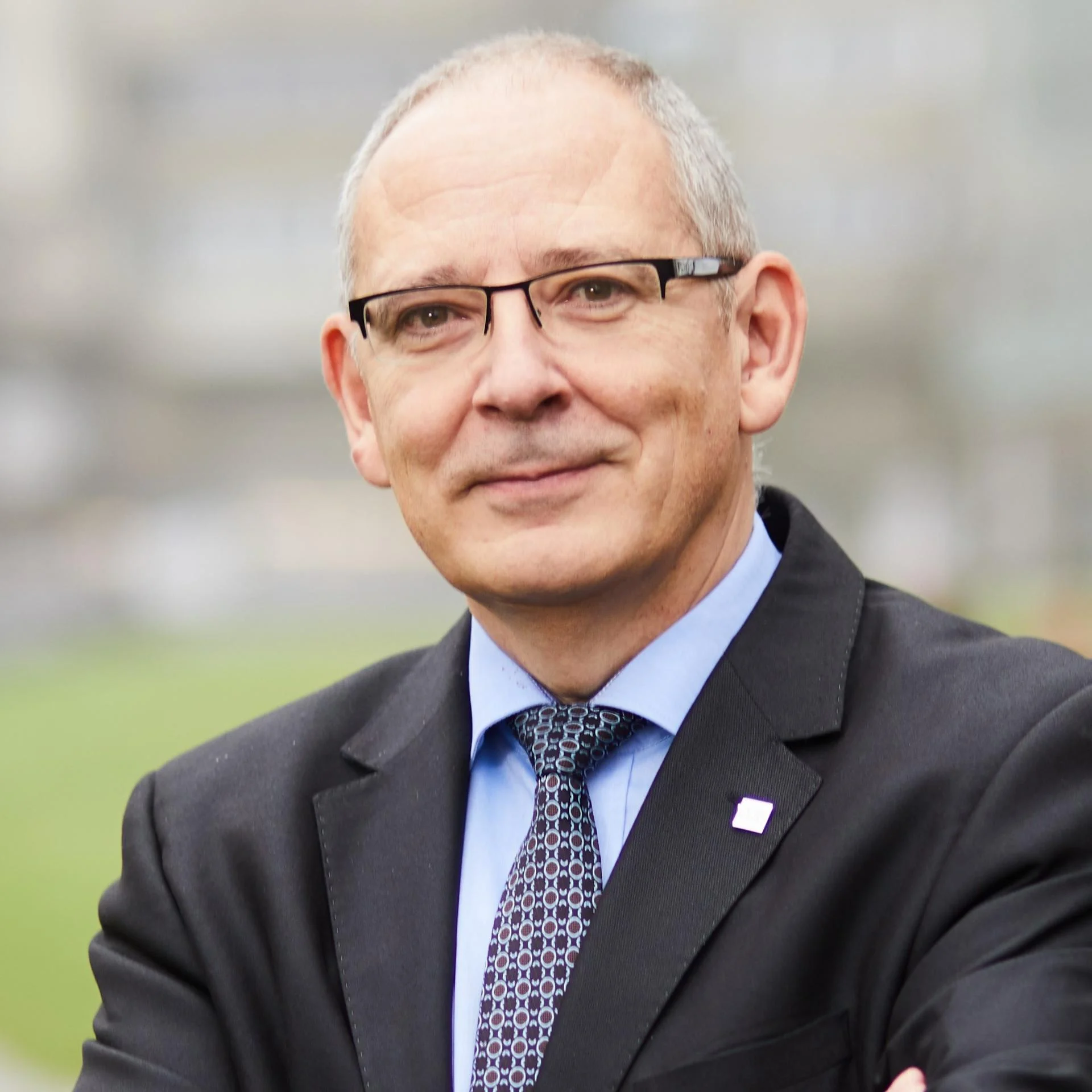
Hugo Thienpont
Vrije Universiteit Brussel
PhotonHub: Accelerating Photonics for Strategic Autonomy and Industrial Growth
PhotonHub is the EU’s flagship innovation hub for photonics—one of the most powerful enabling technologies of the digital and green transitions. By offering streamlined access to technology and business expertise, infrastructure, and hands-on support, PhotonHub helps companies—especially SMEs, start-ups, and scale-ups—rapidly advance both their technology and investment readiness.
Through cross-border collaboration and deep-tech innovation, PhotonHub drives the adoption of photonics across key sectors such as health, manufacturing, energy, space and communications. The initiative plays a vital role in strengthening strategic value chains, fostering high-value job creation, and reinforcing Europe’s technological sovereignty.
As a key instrument within the European innovation ecosystem, PhotonHub delivers tangible impact aligned with EU priorities in competitiveness, resilience, and digital autonomy.
About the speaker
Hugo Thienpont is a professor at the Faculty of Engineering of the Vrije Universiteit Brussel, research director of the VUB Photonics Innovation Center, vice president of Photonics 21, and coordinator of the EC-funded initiative to provide photonics technology and business innovation support to European companies.

Heidi Ottevaere
Vrije Universiteit Brussel, Brussels Photonics
PHORTIFY: PHOtonics education netwoRk for nexT-gen Innovation and digital skills excellence For industrY and society
PHORTIFY is a Digital Europe Programme of the European Commission that aims to create significant added value on top of the existing capabilities for digital skills training in photonics by establishing a well-integrated photonics education and training network on the European scale. PHORTIFY is made up of a critical mass of Europe’s top higher education institutes, research organisations and industrial companies (from start-ups and SMEs to large-scale companies) in the world of photonics. Together the 12 PHORTIFY partners will o er excellent programmes and self-standing modules with harmonised standards for quality assurance and certification together with high degrees of flexibility and mobility for students and industry participants alike. The unique PHORTIFY curriculum will be perfectly aligned with the changing needs of the labour market to support the strong demand for photonics-driven innovation in solving major societal challenges. Through PHORTIFY, we aim to support the transformation of higher education, ensuring Europe’s leadership in training the digital specialists of the future and positioning photonics at the forefront of this digital education revolution.
About the speaker
Since 2009, Heidi has been a professor at the Faculty of Engineering at Vrije Universiteit Brussel (VUB). She is responsible for the Photonics Education Curriculum at VUB and organizes internships that align with the interests and competencies of both students and companies. Since 2019, she chairs the Applied Physics and Photonics Department of the Faculty of Engineering at VUB and leads the Council for International Policy at the faculty. Heidi manages the Instrumentation and Metrology platform at the Photonics Innovation Centre and heads the research unit 'biophotonics' at VUB B-PHOT. Additionally, she has extensive experience in coordinating EU and locally funded research and industrial projects.
Luis Trigo Vidarte
ICFO
PIXEurope Pilto Line for Advanced Photonic Integrated Circuits
PIXEurope is a new ambitious Pilot Line initiative that has been launched by the European Commission, through the Chips Joint Undertaking, to accelerate the development of photonic chip technology—an essential component in the future of high-speed computing, communications, and quantum information systems, among others. The pilot line aims to work on new process and technologies and optimized prototyping chain (that includes design, fabrication, integration, testing and reliability) in search of demonstrating accelerating product development and scalable manufacturability.
During 10 years and with a budget of ~400M€, 20 partnering entities from 11 European countries (Austria, Belgium, Finland, France, Ireland, Italy, Poland, Portugal, Spain, the Netherlands and the United Kingdom) with have the ultimate goal of creating a unified European PIC ecosystem, with open access services to the user, establishing itself as the first fully integrated PIC pilot line in the world.
About the speaker
Luis TRIGO VIDARTE, obtained his PhD at Institut d’Optique/Sorbonne Université in Paris studying practical implementation aspects of CV-QKD technologies, including fiber, space and chips. He is currently, a postdoctoral researcher in the Optoelectronics group at the Institute of Photonics Sciences (Institut de Ciències Fotòniques) in Barcelona area. He focuses on experimental implementations of quantum-safe cryptography protocols, including quantum key distribution (QKD), post-quantum cryptography (PQC), and other quantum security protocols beyond QKD, like secure multiparty computation (SMPC). He is also exploring the potential of photonic implementations in computing and machine learning.
EU Project Sessions I
Jonas Golde
Fraunhofer IWS
Hyperspectral Imaging in Practical Applications: From Acquisition to Compression and Analysis
Hyperspectral imaging has emerged as a powerful tool for the analytical understanding of production processes, biological systems, environmental dynamics, and beyond. Despite its broad application potential, deployment is frequently constrained by optical limitations and, more recently, by practical challenges in data handling, compression, and analysis.
This talk provides an overview of current activities within the HyperImage Project, which addresses these challenges through insights gained from four representative use cases: vertical framing systems, outdoor off-road vehicles, quality control in semiconductor manufacturing, and unmanned aerial vehicles (UAVs).
Drawing on these applications, we present tailored strategies for efficient data management, including filtration, compression, and storage for both short- and long-term use. Special emphasis is placed on intelligent approaches to data reduction and visualization, adapted to the operational constraints of each use case.
About the speaker
Jonas Golde holds a Bachelor's (2013) and Master's degree (2016) in Physics from TU Dresden. From 2016 to 2023, he conducted research in biomedical optics at the Faculty of Medicine, TU Dresden, focusing on optical coherence tomography and related spectroscopic and imaging techniques. Since August 2023, he has been Group Manager for Optical Inspection Technology at Fraunhofer IWS in Dresden.
Homa Zarebidaky
CSEM
ELENA, a coherent European Supply Chain for Scalable TFLN PIC Manufacturing
The ELENA project (European Lithium Niobate Photonic Integrated Circuit Foundry), founded by H2020, aims to establish a complete, sovereign value chain for thin-film lithium niobate (TFLN) photonic integrated circuits (PICs) in Europe. Spanning from LNOI (Lithium Niobate on Insulator) wafer manufacturing to PIC fabrication and packaging, the project brings together material providers, foundry services, and end-users to accelerate the industrial adoption of TFLN technology.
By enabling a scalable, CMOS-compatible TFLN platform, ELENA supports the development and commercialization of advanced photonic components. In addition to that, the feedback from end-users is very crucial. The project targets three key application demonstrators: a high-linearity electro-optic modulator, a widely tunable laser source, and an integrated frequency shifter. These address critical needs in telecommunications, metrology, and emerging quantum technologies.
This talk will present an overview of ELENA’s objectives, the current status of the technology development across the supply chain, and the envisioned impact on Europe’s photonics ecosystem.
About the speaker
Homa Zarebidaki, PhD, is a Senior R&D Engineer and Photonic Component Coordinator at CSEM, working within the Emerging Micro and Nano Technologies group of Business Unit T. Her expertise includes integrated photonics design, process development, and device characterization. She leads the development of advanced photonic components.
Since 2022, she has focused on advancing the thin-film lithium niobate (TFLN) photonic platform, with a particular emphasis on fabrication processes and Process Design Kit (PDK) development. She coordinates group activities in TFLN photonic integrated circuits (PICs), opto-mechanics, and MEMS, and serves as the primary R&D contact for both publicly funded and industrial collaborative projects.
Giuseppe Talli
Huawei Technologies Duesseldorf GmbH
ADOPTION Project – Advancing Data Centre and AI Cluster Interconnects with Co-Packaged Optics for High-Efficiency Cloud Computing
The ADOPTION project set out to target the scaling challenges of hyperscale data centers and AI training clusters networks. As the size and bandwidth requirements for data centers networks continues to increase, the electronic packet switches will be required to deliver more bandwidth than current face-plate pluggable (FPP) modules architecture can support. The power consumption of these networks is also becoming a significant issue.
ADOPTION is developing core technologies for Co-Packaged Optical (CPO) assemblies, integrating optical transceiver cores, or "chiplets," into electronic packet switches, which aim at reducing power consumption and eliminating communication bottlenecks. At the same time ADOPTION has the objective of ADOPTION of the developing innovative optical switching architectures that significantly reduce latency and enhance data throughput. Key goals of the project are the development of: Low Power and Low Cost DWDM Photonics and Transceiver Engines; Innovative Packaging Techniques; Improved Optical Coupling Efficiency, Advanced Laser Arrays and Novel Passive and Active Integrated Optical Routing Elements.
About the speaker
Dr. Giuseppe Talli is currently leading the optical access networks research team in the Huawei Munich Research Centre. He was previously with the Photonic Systems Group at the Tyndall National Institute, University College Cork and Intune Networks and he received his PhD in electronic engineering from the University of Essex in 2003. Throughout his career he has been working in the area of optical fibre access and short reach networks, including integrated photonic components and burst-mode transmission technologies, and has contributed in several EU-funded projects: PIEMAN, VISIT, FABULOUS, QUATERNIAN, DISCUS and ADOPTION.
Susmita Sridhar
TEMATYS
Photonic integrated LIDAR and snapshot spectral imagers for scaling up multimodal perception in precision applications
RETINA is focused on developing advanced photonic-based sensory systems for a variety of industries, including healthcare, automotive, and agriculture. By integrating photonic integrated circuits (PICs) with LIDAR solutions and quantum dot (QD) imagers, the project aims to enhance precision and efficiency in applications like tumor detection, driver assistance systems, and precision agriculture. RETINA combines cutting-edge technology with machine learning for improved perception and analysis.
About the speaker
Susmita Sridhar, PhD, has a doctoral degree in Optics, Photonics and Image processing from Institut Fresnel, Aix-Marseille University (AMU), Marseille and The Institute of Photonic Sciences (ICFO), Polytechnic University of Catalunya (UPC), Barcelona.
Her research career revolved around developing and optimizing optical imaging techniques such as Microscopy and Nanoscopy (SIM, SPT, PALM/STORM), Wide-Field Diffuse Optical systems (Polarization-gated optics), Hyperspectral Imaging etc. for various biomedical applications. For the past 3 years, she has worked at TEMATYS as the Report Production Manager & handles all the European Projects.
EU Project Sessions II

Scarlett Gauthier
Technical University Delft
Quantum Internet Alliance - building global quantum internet made in Europe
The European Quantum Internet Alliance (QIA) is a consortium of ~42 world-leading institutions working together to build a global Quantum Internet made in Europe. By combining QIA’s diverse interdisciplinary team, we will establish an innovative European platform for Quantum Internet development and build a full-stack prototype network that has the potential to become the first of its kind in the world.
About the speaker
Scarlett Gauthier is a member of the Architecture Team of the Quantum Internet Alliance (QIA), where she contributes to the day-to-day technical coordination and monitoring of progress towards QIA’s goal of building a European prototype quantum internet. She is a PhD student in the Quantum Computer Science research group led by Professor Stephanie Wehner at TU Delft. Her research focuses on advancing the quantum internet through contributions to the development of the network control stack.

Ward Hendriks
Aluvia Photonics
QU-PIC: Universal PIC Platform for Broadband (UV-IR) Quantum Applications
The QU-PIC project focuses on leveraging the aluminum oxide platform, known for its broadband, from UV to IR, low loss and high-power handling capabilities. This universal pic platform enables the integration of several key building blocks for quantum applications, such as extended cavity diode lasers down to 280 nm, electro-optic modulators, and superconducting nanowire single photon detectors. These components are crucial for developing advanced quantum systems, including quantum ion traps, thereby fostering the growth of quantum technologies within Europe and ensuring European sovereignty in this rapidly evolving sector.
About the speaker
Ward Hendriks, the Chief Technology Officer (CTO) of Aluvia Photonics, leads advancements in photonic integrated circuits (PICs) on the Al2O3 platform, which supports applications ranging from UV to MidIR. With a background in applied physics and a decade of experience in all aspects of the development of photonic integrated devices, Ward is uniquely positioned to drive Aluvia's foundry services forward. His deep understanding of integrated optics and pioneering work on aluminum oxide development as a new platform for integrated photonics, including on-chip amplification by rare earth dopants, highlight his dedication to expanding the boundaries of photonics. As CTO, he leads Aluvia Photonics' mission to deliver innovative, customized solutions for various industries, setting new standards in photonic integration.

Iñaki Barettini
ICFO
QSNP. The European Initiative for the Development of Quantum-Safe Networks
This talk will introduce the main objectives and results of QSNP, the European initiative for the development of quantum-safe networking. QSNP is mainly focused on developing the underlying technology for building large-scale, quantum-safe communication networks and services, on cost-effective and integrated devices and systems. QSNP is committed towards the integration of these quantum technologies with classical communication networks, secure communication over large distances and support applications beyond QKD, such as long-term secure storage, multi-party computation between untrusted players, and clock synchronization. The final aim is to build a European and global ecosystem, a virtuous cycle, in which basic technology generates improved and new products and services that, in turn, foster more basic technology, all of this leading to significant economic and societal impact.
About the speaker
Iñaki Barettini is a Senior Manager with more than 25 years of experience in different application technologies like physical and logical security, cryptography, authentication, AI and Quantum technologies. He has held various senior positions in Sales, Marketing and Business Development in some of the most renowned players in the industry. He holds a MSc. in Physics and an Electronics Engineer degree, complemented with executive education in the fields of Business, Sales and Marketing. Currently Iñaki is Quantum Technologies Business Development at ICFO and also QSNP Innovation Manager, covering various market segments like Telecom, Government, Critical Infrastructure, Banking, Finance, Transport and Energy, among others. Iñaki is multi-cultural character, with job experiences in Europe, Asia and the Americas, able to work and understand different sensitivities both in the professional and in the personal field.
Andrea Farina
CNR
CONcISE: a Journey into Imaging, Computation and Collaboration
CONcISE is a Doctoral Nework formed to train 11 young researchers in developing new, computational imaging techniques to study biological tissues. The project brings together experts from different fields, including lab research, computer science, and industry to offer a rich and multidisciplinary training for the researchers. The main goals of the project will be shared along with the story of how the consortium come together.
About the speaker
Andrea Farina obtained his Master’s Degree in Electronics Engineering from Politecnico di Milano in 2006 and his PhD in Physics in 2009 from the same institution.
Since 2011 he has been a Staff Researcher at the Institute for Photonics and Nanotechnologies of the National Research Council (IFN – CNR) in Milan. From 2011 to 2017, he also served as a contract professor of Physics at Politecnico di Milano.
His research activity focuses on the development of innovative techniques for multi-dimensional imaging of biological tissues using computational techniques, including diffuse optical tomography (DOT) and spectroscopy (DOS), multispectral fluorescence lifetime imaging (FLIM), single-pixel imaging and compressed sensing.
